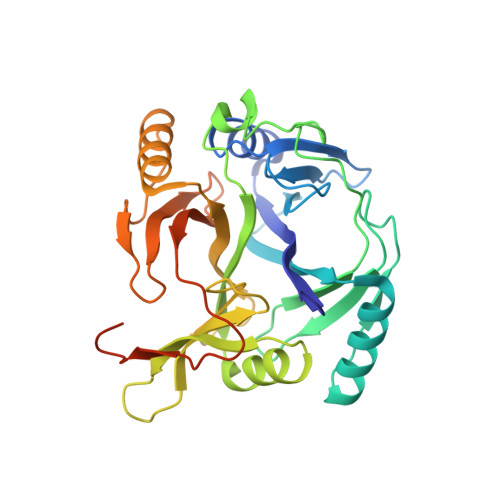Crystal structure and functional analysis of the extradiol dioxygenase LapB from a long-chain alkylphenol degradation pathway in Pseudomonas
Cho, J.-H., Jung, D.-K., Lee, K., Rhee, S.(2009) J Biol Chem 284: 34321-34330
- PubMed: 19828456
- DOI: https://doi.org/10.1074/jbc.M109.031054
- Primary Citation of Related Structures:
3HPV, 3HPY, 3HQ0 - PubMed Abstract:
LapB is a non-heme Fe(II)-dependent 2,3-dioxygenase that catalyzes the second step of a long-chain alkylphenol (lap) degradation pathway in Pseudomonas sp. KL28 and belongs to the superfamily of type I extradiol dioxygenases. In this study, the crystal structures of substrate-free LapB and its complexes with a substrate or product were determined, along with a functional analysis of the active site residues. Structural features of the homotetramer are similar to those of other type I extradiol dioxygenases. In particular, the active site is located in the C-domain of each monomer, with a 2-His-1-carboxylate motif as the first coordination shell to iron ion. A comparison of three different structures in the catalytic cycle indicated catalysis-related local conformational changes in the active site. Specifically, the active site loop containing His-248 exhibits positional changes upon binding of the substrate and establishes a hydrogen-bonding network with Tyr-257, which is near the hydroxyl group of the substrate. Kinetic analysis of the mutant enzymes H248A, H248N, and Y257F showed that these three mutant enzymes are inactive, suggesting that this hydrogen-bonding network plays a crucial role in catalysis by deprotonating the incoming substrate and leaving it in a monoanionic state. Additional functional analysis of His-201, by using H201A and H201N mutants, near the dioxygen-binding site also supports its role as base and acid catalyst in the late stage of catalysis. We also noticed a disordered-to-ordered structural transition in the C-terminal region, resulting in the opening or closing of the active site. These results provide detailed insights into the structural and functional features of an extradiol dioxygenase that can accommodate a wide range of alkylcatechols.
Organizational Affiliation:
Department of Agricultural Biotechnology, Seoul National University, Seoul 151-921, Korea.
















